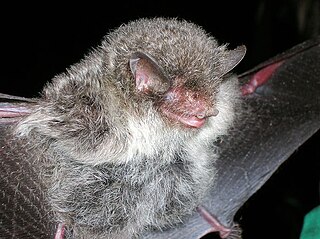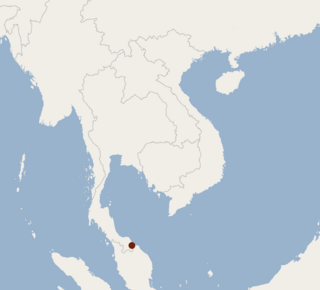
Vespertilionidae is a family of microbats, of the order Chiroptera, flying, insect-eating mammals variously described as the common, vesper, or simple nosed bats. The vespertilionid family is the most diverse and widely distributed of bat families, specialised in many forms to occupy a range of habitats and ecological circumstances, and it is frequently observed or the subject of research. The facial features of the species are often simple, as they mainly rely on vocally emitted echolocation. The tails of the species are enclosed by the lower flight membranes between the legs. Over 300 species are distributed all over the world, on every continent except Antarctica. It owes its name to the genus Vespertilio, which takes its name from a word for bat, vespertilio, derived from the Latin term vesper meaning 'evening'; they are termed "evening bats" and were once referred to as "evening birds".

The velvety myotis, is a species of vesper bat from South America.

Murina is a genus of vesper bats. They are found throughout temperate and tropical regions of Asia.

The Ussuri tube-nosed bat is a species of vesper bat in the family Vespertilionidae. It is threatened by habitat loss. It is the only species of bat that hibernates in snowbanks.

The blunt-eared bat or Peruvian crevice-dwelling bat is a species of bat in the family Molossidae. It is monotypic within the genus Tomopeas and subfamily Tomopeatinae. It is endemic to Peru, where it is considered critically endangered. It is threatened by habitat loss.

The Murininae are a subfamily of bats in the family Vespertilionidae. They include the tube-nosed bats and hairy-winged bats in the genera Murina, Harpiola, and Harpiocephalus.

Harrison's tube-nosed bat is a species of vesper bats (Vespertilionidae). Within the genus Murina, it belongs to the so-called 'cyclotis-group'.

Beelzebub's tube-nosed bat, also Beelzebub bat or demon bat, is a species in the vesper bat family Vespertilionidae, found in the Greater Mekong region of Southeast Asia, specifically the Quảng Trị and Gia Lai provinces of Vietnam. They have tube-shaped nostrils which assist them with their feeding.

The Bala tube-nosed bat is a critically endangered species of bat found in Thailand.
Rosevear's serotine is a species of vesper bat that lives in Guinea and Liberia. It was described as a new species in 2013. It is listed as endangered by the IUCN.
The bicolored tube-nosed bat is a species of vesper bat endemic to Taiwan.

Myotis izecksohni is a species of mouse-eared bat that is endemic to Brazil and Argentina.
The hidden tube-nosed bat is a species of bat found in Taiwan.
Ward's long-eared bat is a species of vesper bat in the family Vespertilionidae. It is found in mountainous regions of South Asia and adjoining regions.
The rainforest tube-nosed bat is a species of vesper bats (Vespertilionidae). It is found in India.
Lorelie's tube-nosed bat is a species of vesper bat in the family Vespertilionidae. It is endemic to southern China, where it is known only from Yunnan and Guangxi provinces. It is named after chiropterist Lorelie Mitchell.
The Shuipu tube-nosed bat or Shuifu tube-nosed bat is a species of vesper bat in the family Vespertilionidae. It is endemic to southern China, where it is known only from Guangxi province. It is named after the type locality, Shuipu Village.
Murina guilleni is a species of vesper bat found in Thailand and the Nicobar Islands.









